
Chapter 8; Static Equilibrium
8.3, 10, 22, 29, 52, 55, 56, 74
![]()
| ToC, Ch 8 | Course Calendar|
![]()

![]()
| ToC, Ch 8 | Course Calendar|
![]()
8.3 A 2-kg ball is held in position by a
horizontal string and a string that makes an angle of 30° with
the vertical, as shown in the figure. Find the tension T in the
horizontal string.
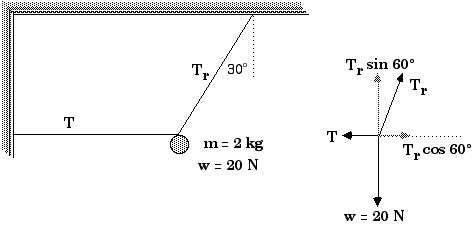
(Since I am writing this all in bold to begin with, it is difficult or impossible to explicitly tell that this is a vector equation--but it is! And that's very important!)
But that really means
![]() Fx
= 0
Fx
= 0
![]() Fy
= 0
Fy
= 0
![]() Fx
= - T +
Tr
cos 60° = 0
Fx
= - T +
Tr
cos 60° = 0
![]() Fy
=
Tr
sin 60° - 20 N = 0
Fy
=
Tr
sin 60° - 20 N = 0
![]()
8.10 The pulleys shown in the figure below are frictionless but
have a mass of 4 kg each. What is the tension in the cord and in the
pulley supports?
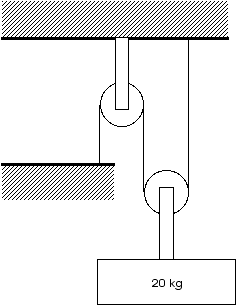
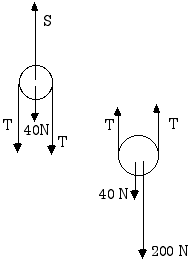
Apply the first condition of equilibrium to
each pulley.
First to the one one the left,
That gives two unknowns in one equation so we must seek additional information. Of course, that will come from looking at the pulley on the right,
8.22 a cable and pulley arrangement shown there. The coefficient
of friction between the two blocks is
0.4.
The coefficient of friction between the block and the floor is 0.4.
What is the maximum external horizontal force F that can be exerted
on the lower block before it will move? What is the tension in the
cable?
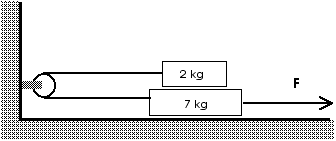
The maximum external force F that can be exerted will be the force exerted when the friction forces are at their maxima,
Make careful free body diagrams of the forces
on each block.
First, for the 2-kg block, we have

But that really means
With the normal force on the 2 kg block known, we can readily
calculate the friction force,
![]() Fx
= 0
Fx
= 0
![]() Fy
= 0
Fy
= 0
![]() Fx
= Ff
- T = 0
Fx
= Ff
- T = 0
![]() Fy
= FN
- 20 N =
0
Fy
= FN
- 20 N =
0
And that also means
Now, look at all the forces on the 7-kg block,
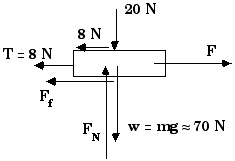
The downward 20 N-force on top of the block is the normal force exerted by the 2-kg block. The 8-N force on the top is the friction force exerted by the 2-kg block. The tension is still 8 N just as it was at the other end of the string which is attached to the 2-kg block. The forces labeled FN and Ff are the normal force and friction force exerted at the bottom on this 7-kg block, of course. We used the same symbols to represent different forces earlier when we looked at the 2-kg block. Now we are ready to again apply the first condition of equilibrium,
But that really means
|
|
|
|
|
|
|
|
|
|
|
With the normal force on the 7-kg block known, we can readily calculate the friction force,
8.29 A piece of pipe may sometimes be used as a "cheater" to
effectively lengthen the moment arm of a wrench. If a pipe is used as
shown in the figure to allow a 150 N force to be exerted 30 cm from
the bolt, what torque is exerted on the bolt?
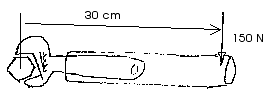
![]() = r F sin
= r F sin ![]()
![]() = (0.30 m) (150 N) (1)
= (0.30 m) (150 N) (1)
![]() = 45 m-N
= 45 m-N
8.35 (original) A uniform pole 6 m long weighs 300
N and is attached by a pivot at one end to a wall. The pole is
held at an angle of 30° above the horizontal by a horizontal guy
wire attached to the pole 4.0 m from the end attached to the wall. A
load of 600 N hangs from the upper end of the pole. Find the tension
in the guy wire and the components of the force exerted on the pole
by the wall.
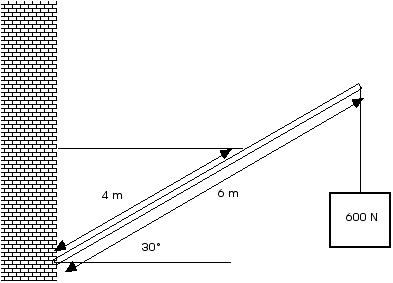
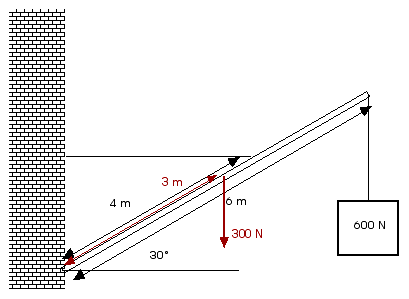
As always, a free body diagram is
essential.
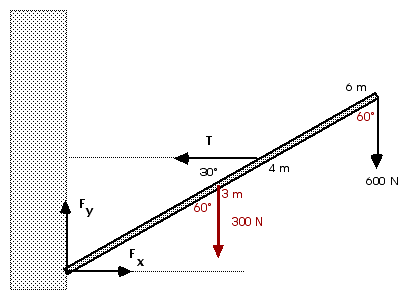
From the first condition of equilibrium, we have
But that really means
|
|
|
|
|
|
|
|
|
|
|
More information is needed to solve for T and Fx. We can get that information from the second condition of equilibrium. Before we start to calculate torques, we must decide on the reference point about which we will calculate those torques. If we choose the lower, left end of the pole, there are two forces, Fx and Fy, that will have zero torque. That will reduce the number of terms in all of our equations. Therefore, that is a good choice for the origin or reference point or axis of rotation.
Fx:
![]() = 0 (since r = 0 in
= 0 (since r = 0 in ![]() = r F sin
= r F sin ![]() )
)
Fy:
![]() = 0 (since r = 0 in
= 0 (since r = 0 in ![]() = r F sin
= r F sin ![]() )
)
T: ![]() ccw
= (4 m)(T)(sin 30°) = (4 m) T
(0.50)
=
(2
m) T
ccw
= (4 m)(T)(sin 30°) = (4 m) T
(0.50)
=
(2
m) T
600 N: ![]() cw
= (6 m)(600 N)(sin 60°) = (6 m)(600
N)(0.866)
=
3118
m-N
cw
= (6 m)(600 N)(sin 60°) = (6 m)(600
N)(0.866)
=
3118
m-N
300 N: ![]() cw
= (3 m)(300 N)(sin 60°) = (3 m)(300
N)(0.866)
= 779 m-N
cw
= (3 m)(300 N)(sin 60°) = (3 m)(300
N)(0.866)
= 779 m-N
![]()
![]() ccw
=
ccw
= ![]()
![]() cw
cw
(2 m) T = 3118 m-N + 779
m-N
(2 m) T = 3897 N
T = (3897/2) N
T = 1948.5 N
Therefore,
Fx = 1948.5 N
And we already knew
8.35
(modified)
A
lightweight,
uniform pole is 6 m long and is attached by a pivot at one end to a
wall. The pole is held at an angle of 30° above the horizontal
by a horizontal guy wire attached to the pole 4.0 m from the end
attached to the wall. A load of 600 N hangs from the upper end of the
pole. Find the tension in the guy wire and the components of the
force exerted on the pole by the wall.

As always, a free body diagram or a force
diagram is
essential.
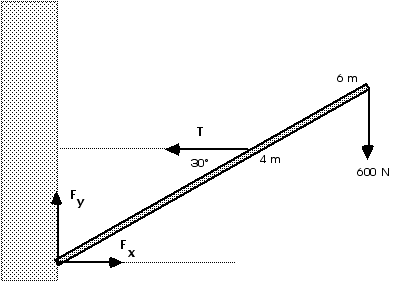
From the first condition of equilibrium, we have
But that really means
|
|
|
|
|
|
|
|
|
|
|
More information is needed to solve for T and Fx. We can get that information from the second condition of equilibrium. Before we start to calculate torques, we must decide on the reference point about which we will calculate those torques. If we choose the lower, left end of the pole, there are two forces, Fx and Fy, that will have zero torque. That will reduce the number of terms in all of our equations. Therefore, that is a good choice for the origin or reference point or axis of rotation.
Fx:
![]() = 0 (since r = 0 in
= 0 (since r = 0 in ![]() = r F sin
= r F sin ![]() )
)
Fy:
![]() = 0 (since r = 0 in
= 0 (since r = 0 in ![]() = r F sin
= r F sin ![]() )
)
T: ![]() ccw
= (4 m)(T)(sin 30°) = (4 m) T
(0.50)
=
(2
m) T
ccw
= (4 m)(T)(sin 30°) = (4 m) T
(0.50)
=
(2
m) T
600 N: ![]() cw
= (6 m)(600 N)(sin 60°) = (6 m)(600
N)(0.866)
=
3118
m-N
cw
= (6 m)(600 N)(sin 60°) = (6 m)(600
N)(0.866)
=
3118
m-N
![]()
![]() ccw
=
ccw
= ![]()
![]() cw
cw
(2
m) T =
3118
m-N
T =
1559
N
Therefore,
Fx = 1559 N
And we already knew
8.41 A carpenter's square has the dimensions shown in the figure.
It is made of uniformly thick metal. Locate its center of
gravity.
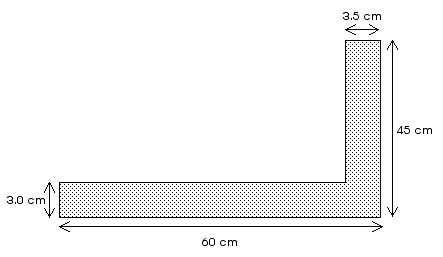
Think of the square as being made of two rectangles.
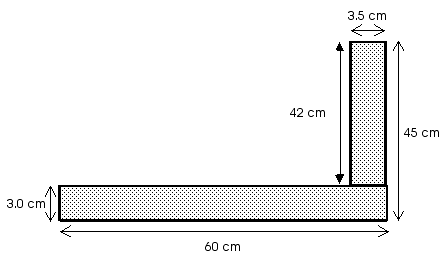
The center of gravity of each rectangle is at the geometric center of that rectangle and the mass (or weight) located at that position is proportional to the area of that rectangle.
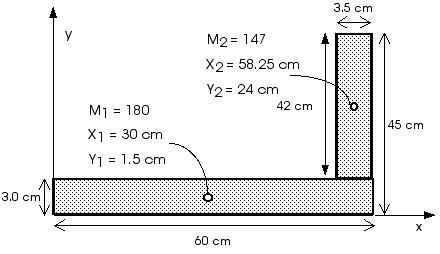
Notice that the positions are all measured from the lower left corner of the carpenter's square. Now we can use the defintions of center of gravity, Equations 8.10 and 8.11, to locate the center of gravity of the entire object,
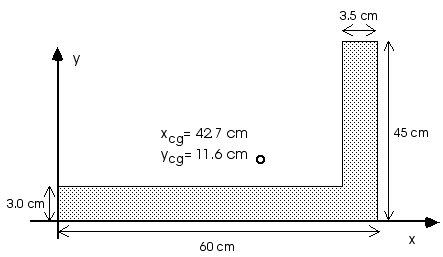
8.52 Ladder problems are fun. Ladder problems are classic. A ladder
problem will surely reappear on an hour exam or the final. A man
who weighs 800 N climbs to the top of a 6 meter ladder that is
leaning agains a smooth (ie, frictionless) wall at an angle of
60° with the horizontal as sketched in the figure below. The
non-uniform ladder weighs 400 N and its center of gravity is 2 meters
from the foot of the ladder. What must be the minimum coefficient of
static friction between the ground and the foot of the ladder if it
is not to slip?
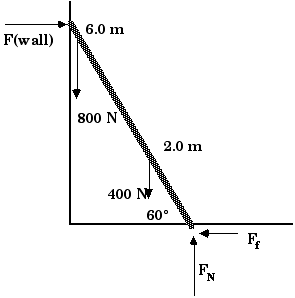
Using the first condition of equilibrium, we have
Fwall = Ff
and
FN = 1200 N
To solve for Fwall and, thus, for Ff, we must use the second condition of equilibrium. In calculating the torques, let us calculate torques about the foot of the ladder. That choice means two of the forces, FN and Ff , will provide zero torque and that reduces the number of terms in our equations. Be very careful of the angles!
Fwall:cw = (6.0 m)(Fwall)(sin 60°) = (6.0 m)(Fwall)(0.866)
cw = (5.2 m) Fwall
800 N:
ccw = (6.0 m)(800 N)(sin 30°) = 2400 m-N
400 N:ccw = (2.0 m)(400 N)(sin 30°) = 400 m-N
Fwall:
= 0
Ff:= 0
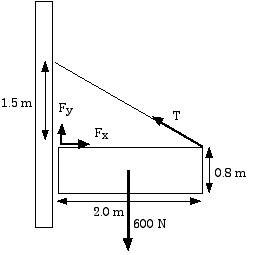
Call the components of the force exerted by the pin Fx and Fy. The angle between the guy wire and the horizontal is
Start with the first condition of equilibrium,
Fx
= 0.80 T
![]() Fy
=
Fy
+ T sin 37° - 600 N = 0
Fy
=
Fy
+ T sin 37° - 600 N = 0
Fy
+ 0.60 T = 600 N
This leaves us with two equations but three unknowns, so some additional information is required. Of course, we can get that by applying the second condition of equilibrium. We will calculate torques about the pin. This means the torque caused by the force of the pin is zero. Be careful of the torque for the 600-N weight.
T:ccw = (2.0 m)(T)(sin 37°) =(2.0 m)(T)(0.60) =(1.2 m)T
Fx:= 0
Fy:= 0
W:cw = (1.0 m)(600 N) = 600 m-N
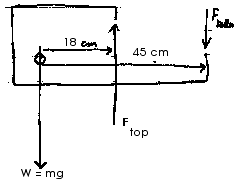
From the first condition of equilibrium, we have
Calculate torques about the position of the child,
W:= 0
Ftop:ccw = (18 cm)Ftop
Fbottom:cw = (45 cm) Fbottom
Now apply the second condition of equilibrium,
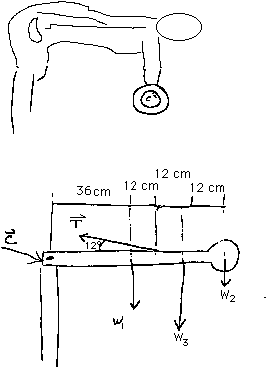
Ooops, I forgot to give you values for
w1 and
w2;
w3 is the weight of
294 N (the 30-kg mass that is being lifted). Read problem 8.73 for
those values;
w1
= 480 N and ww = 60
N.
From the first condition of equilibrium we have
and
We now have two equations with three unknowns so we must get additional information from the second condition of equilibrium. We will calculate torques about the hip; that means the torque exerted by the compressive force C will be zero.
C:= 0
T:ccw = (48 cm) T (sin 12°) = (48 cm) T (0.208)
= (9.98 cm) Tw1:
cw = (36 cm)(480 N) = 17 280 cm-N
w2:cw = (72 cm)(60 N) = 4 320 cm-N
w3:cw = (48 cm)(294 N) = 14 112 cm-N
The negative sign here simply means that while we assumed that Cy pointed down, Cy actually points up.
| ToC, Ch 8 | Course Calendar|
![]()
(c) 2000, Doug Davis; all rights reserved.